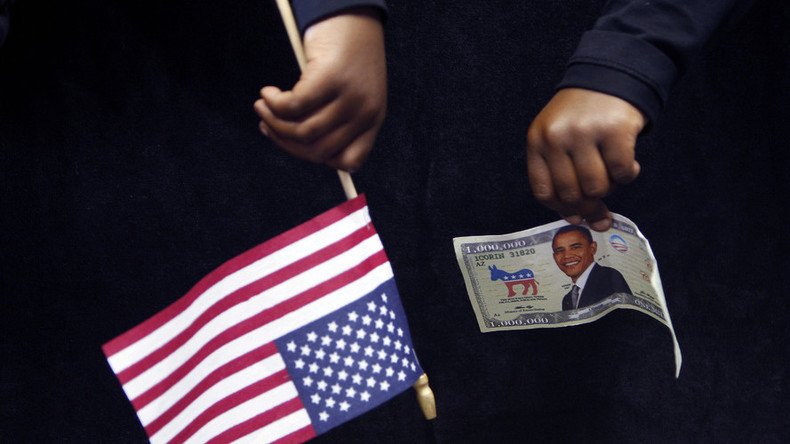Top ‘1 percent’ in US blooms as income inequality grows, despite Obama’s efforts – report

Despite President Obama’s efforts to fight income inequality, the gap is widening. The wealthiest “one percent” take in most of the growth, a new study shows. The last 35 years saw the richest Americans’ income jump 10 times higher than the other 99 percent.
“Market income in 2013 for households in the top 1 percent was 188 percent higher than it was in 1979,” the Congressional Budget Office said in the report released Wednesday. “For households in the bottom four income quintiles, market income was 18 percent higher in 2013 than it was in 1979.”
According the new federal data, a typical American household earned market income of $86,000 in 2013. After adding another $14,000 in government benefits per household, their pretax income reached $100,000. In that scenario, consumers kept $80,000 annually after paying 20 percent in taxes.
US corporate CEOs earn 335 times more money than employees – report https://t.co/vVECdTZgPnpic.twitter.com/P5xYVxIw6m
— RT (@RT_com) May 17, 2016
In the meantime, in 2013, America’s richest “one percent,” made up of 1.2 million households across the country, earned on average nearly $1.6 million annually per household. The CBO estimates that in the last 35 years, after-tax income of those richest households saw at least 3 percent growth each year. Thus, in 2013, their income after paying federal taxes was 192 percent higher than it was in 1979.
In comparison, over the same period, households “at the bottom” saw their income grow only 1 percent per year on average, bringing their earnings up only 46 percent during those 35 years.
Despite the remaining wide gap between the “one percent” and the rest of the US, income inequality declined during the first five years of Obama's presidency.
The White House successfully tamped down after-tax inequality by applying changes in the federal tax system in 2012 and 2013, when tax rates for the richest Americans rose more than five percentage points. That was the largest tax increase in 20 years.
Life expectancy gap between rich and poor is growing – study https://t.co/CTD0qLJxfFpic.twitter.com/XZWDCjaaXB
— RT America (@RT_America) February 22, 2016
In 2013, the “one percent” paid about $70,000 in federal taxes per household compared to $9,000 taken from the middle class and less than $1,000 from lower class families.
"That decrease in income inequality stemmed primarily from the higher rates faced by high-income taxpayers in that year, which made the federal tax system the most progressive it has been since the mid-1990s," the CBO said.
What took even a bigger bite out of inequality was the Obama administration’s transfer policies, which largely go to low-income households.
In fact, in each year between 1979 and 2013, government transfers reduced income inequality significantly more than the federal tax system did, the CBO estimated.
At the same time, President Obama has also increased benefits, as exemplified by the Affordable Care Act and expansion of Medicaid coverage.












